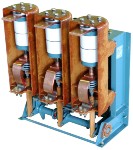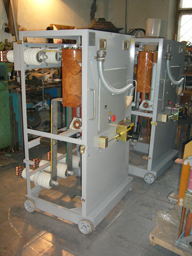Maintenance of high voltage oil and vacuum circuit breakers
Purpose of switches for high voltage
Switches are used to switch electrical circuits in all modes of operation: including disconnection of load currents, short-circuit currents, magnetizing currents of transformers, charging currents of lines and buses.
The heaviest duty of a circuit breaker is the breaking of short circuit currents. When short-circuit currents flow, the breaker is exposed to significant electrodynamic forces and high temperatures. In addition, any automatic or manual reclosing of an irreversible short circuit is associated with the destruction of the gap between the converging contacts and the passage of the shock current at low pressure in the contact, which leads to their premature wear. To increase the service life, the contacts are made of metal ceramics.
The design of circuit breakers is based on different principles. arc extinguishing.
The main requirements for switches in all modes of operation are:
a) reliable disconnection of any currents within the rated values.
b) cut-off speed, i.e. extinguishing the arc in the shortest possible time.
(c) automatic reclosing capability.
d) explosion and fire safety.
e) ease of maintenance.
Circuit breakers of various types and designs are currently used in stations and substations. Predominantly used oil tank switches with large oil volume, low oil switches with small oil volume and vacuum switches.
Operation of oil switches
 In large volume tank circuit breakers, oil is used both to extinguish the arc and to isolate conductive parts from grounded structures.
In large volume tank circuit breakers, oil is used both to extinguish the arc and to isolate conductive parts from grounded structures.
Arc quenching in oil circuit breakers is provided by the action of an arc medium — oil — on it. The process is accompanied by strong heating, oil decomposition and gas formation. The gas mixture contains up to 70% hydrogen, which determines the high ability of the oil to suppress the arc.
The higher the value of the current to be switched off, the more intense the gas formation and the more successful the extinguishing of the arc.
The speed of the contacts in the switch also plays an important role. At a high speed of contact movement, the arc quickly reaches its critical length, where the recovery voltage is insufficient to break the gap between the contacts.
The viscosity of the oil in the switch adversely affects the contact speed. Viscosity increases with decreasing temperature.The thickening and contamination of the lubricant of the friction parts of the transmission mechanisms and drives is largely reflected in the speed characteristics of the switches. It happens that the movement of the contacts becomes slower or stops completely, and the contacts freeze. Therefore, during the repair, it is necessary to replace the old grease in the friction units and replace it with new antifreeze grease CIATIM-201, CIATIM-221, GOI-54.
Operation of vacuum breakers
 The main advantages of vacuum circuit breakers are the simplicity of design, high degree of reliability and low maintenance costs. They have found application in electrical installations with a voltage of 10 kV and more.
The main advantages of vacuum circuit breakers are the simplicity of design, high degree of reliability and low maintenance costs. They have found application in electrical installations with a voltage of 10 kV and more.
The main part of the vacuum breaker is the vacuum chamber. The cylindrical body of the chamber consists of two sections of hollow ceramic insulators connected by a metal gasket and closed at the ends with flanges. Inside the chamber are located a contact system and electrostatic screens that protect the insulating surfaces from metallization by contact erosion products and contribute to the distribution of potentials inside the chamber. The fixed contact is firmly attached to the lower flange of the chamber. The movable contact passes through the upper flange of the chamber and is connected to it by a stainless steel sleeve, creating a hermetically sealed movable connection. The breaker pole chambers are mounted on a metal frame with supporting insulators.
The movable contacts of the cameras are controlled by a common drive using insulating rods and move 12 mm during tripping, which makes it possible to achieve high tripping speeds (1.7 … 2.3 ms).
Air is drawn from the chambers to a high vacuum that remains throughout their lifetime. Thus, the extinguishing of an electric arc in a vacuum circuit breaker occurs in conditions where there is practically no medium conducting an electric current, due to which the insulation of the interelectrode gap is restored very quickly and the arc is extinguished when the current passes through zero value for the first time. Therefore, the erosion of the contacts under the action of the arc is negligible. The instructions allow for contact wear of 4mm. When servicing the vacuum switches, check for the absence of defects (chips, cracks) on the insulators and contamination of their surfaces, as well as for the absence of traces of corona discharges.
